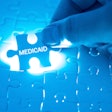Medicaid has a reputation problem. Low reimbursement rates, hefty administrative burdens, difficulty scheduling appointments, and social stigmas around beneficiaries and providers who serve them top the list of grievances.
But for those who rely on Medicaid to keep themselves and their families healthy, it’s a critical program. It’s a worthwhile program. It can be a literal lifeline for some communities.
 Brian Jones.
Brian Jones.
It’s time we rethink our approach to Medicaid dental programs. For too long, we have depended on a transactional relationship between payers, providers delivering critical care, and patients with significant needs.
We need to refocus on community health. Research demonstrates that high-quality oral health reduces a person’s risk of systemic disease, improves quality of life, and promotes a healthier lifestyle. These benefits should be nonnegotiable. But the dental professionals responsible for this critical care face an uphill battle.
The challenges we face
The challenges facing Medicaid dental programs require innovation and collaboration from policymakers, providers, insurers, and technology developers. We can only create sustainable models that improve outcomes and access for underserved populations by working together.
The financial barriers for dentists serving Medicaid patients are real. According to the Education Data Initiative, the average dental school graduate owes $296,500 in student debt; 42% of recent graduates owe even more.
In addition, Medicaid reimbursements -- i.e., 40% to 60% less than earnings from fee-for-service programs or commercial carriers -- often fail to reflect the true cost of providing care. For many dentists, the complexity of navigating different state programs further discourages participation.
There is also a severe shortage of dental professionals across the country. Almost 60 million Americans live in areas that lack adequate dental services, according to the U.S. Department of Health and Human Services.
In county health clinics nationwide, dental chairs and suites are ready to go, but there are no dentists to perform the services. Often, there aren’t even hygienists to handle basic cleanings. Moreover, it can take up to eight years before new dental students start practicing.
Despite these challenges, everyone deserves access to oral healthcare. A healthy smile is a person’s first impression, and oral health is a gateway to whole-body wellness.
Those who are self-conscious about their teeth or breath may avoid smiling, speaking, or interacting. Conditions like cavities and gum disease intensify these challenges, potentially hindering educational opportunities, social development, and career mobility.
Reimagining Medicaid dentistry
Providing access to oral care requires a collaborative approach. Dental professionals are starting to realize that value-based care models can make early intervention and minimally invasive care financially viable.
These models have proven to be effective for underserved populations in improving outcomes while reducing costs. Organizations, including state Medicaid programs and private insurers, are piloting innovative approaches to expand access and prioritize preventive care for these groups.
At Avēsis, we’re committed to making Medicaid participation easier for providers by:
- Streamlining the claims processes: Our simplified claims submission system reduces administrative time, enabling providers to focus on patient care. Claims are processed quickly and transparently, with clear communication on reimbursement timelines.
- Maximizing reimbursements: We provide resources to inform providers of all applicable billing codes, including preventive counseling, salivary testing, and minimally invasive interventions.
- Dedicated provider support: Our support team offers personalized assistance to help providers navigate Medicaid policies, resolve issues, and optimize their participation. This support reduces complexity and removes barriers that discourage dentists from serving Medicaid populations.
Success stories
Across the country, our projects have delivered valuable insights and meaningful results. We enhance how we serve patients and support providers by testing new ideas, adapting quickly, and scaling proven solutions.
In California, we achieved a 27% increase in preventive visits by incentivizing providers to prioritize high-risk age groups, such as children receiving sealants on first molars. In Georgia, our value-based care program led to an average monthly savings of $67 per member by aligning incentives with better care and operational improvements. In Kentucky, we reduced opioid overprescription by 91% in six months through targeted data analysis and provider education.
Advancements in salivary testing are also redefining oral health assessments. These noninvasive chairside tests provide real-time data, enabling dental professionals to make immediate, informed decisions.
Saliva contains biomarkers that can signal susceptibility to systemic conditions like diabetes, cardiovascular disease, and rheumatoid arthritis. New pilot programs, including one conducted in rural West Virginia, have even demonstrated the potential of salivary testing to uncover undiagnosed conditions like prediabetes and diabetes.
Finally, Avēsis offers pay-for-quality incentives that reward measurable improvement in patient health. For example, dentists who help reduce patient cavities between visits can earn a bonus, demonstrating the benefits of partnering with us and Medicaid patients. We cannot change a state’s reimbursement structure, but we can work within the system to create meaningful incentives that support better care and stronger provider engagement.
A call to action
These success stories demonstrate advancements in Medicaid dentistry and underscore the importance of navigating state-specific challenges. Programs like those in California and Georgia succeeded because we worked with state Medicaid agencies and providers, adapting strategies to fit local needs and policies. This flexibility is critical for replicating success nationwide.
Many dentists, including those serving Medicaid populations, may not fully realize their immense impact on oral healthcare in their communities. While volunteering at events like missions of mercy or one-day clinics has an effect, sustaining long-term change requires a broader commitment. By raising awareness of the connection between oral health and whole-body wellness, we can partner to create lasting health outcomes.
If reimbursement is the primary barrier to serving Medicaid patients, we can help overcome it. We cannot always offer increased fee schedules, but we’re committed to innovative technologies and programs that improve patient outcomes. Our goal is to transform the payer-provider relationship from transactional to genuinely collaborative.
Policymakers can help increase Medicaid reimbursement rates and simplify administrative processes. Providers can embrace new technologies like salivary testing to improve patient care and outcomes. Insurers must continue to develop value-based care models that align financial incentives with patient health. By working together, we can expand access and deliver the highest quality care to those who need it most.
Brian Jones is the chief growth officer at Avēsis, a dental and vision specialty benefits provider. He leads initiatives to enhance healthcare access and outcomes for Medicaid, Medicare, and other populations with special healthcare needs.
The comments and observations expressed herein do not necessarily reflect the opinions of DrBicuspid.com, nor should they be construed as an endorsement or admonishment of any particular idea, vendor, or organization.



















